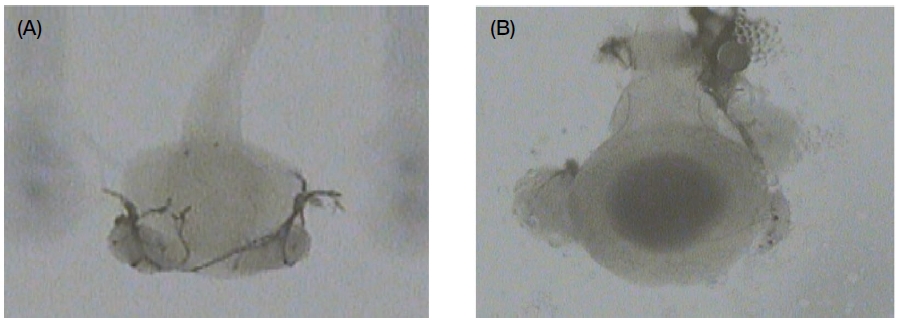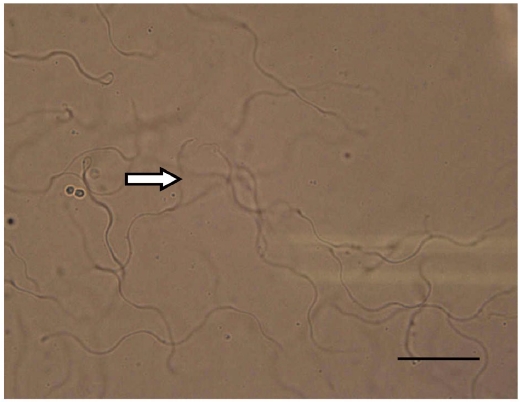
서양뒤영벌 (Bombus terrestris)의 난소 발육과 정자 생산성
Abstract
We investigated ovary development and sperm productivity at the age after eclosion to secure superior traits of Bombus terrestris. As the results, the ovary of mated queen tends to be slightly more development than that of non-mated queen. In the number of eggs per ovariole and spermatheca size, ovary of mated and non-mated queen was the most developed at 15 days and 20 days after eclosion, respectively. In case of male, the number of sperm of non-mated male was 236 thousand at one day after eclosion, and was highest as 497 thousand at 9 days, and tended to show a dramatic decline at 35 days (87 thousand). The number of sperm of mated male was similar to that of non-mated male, but was 1.1~1,7 times more less. The number of sperms was the highest at 9 days after eclosion. In investigating the number of sperm within spermatheca, the number of sperm within spermatheca of mated queen was 22.5~28.1 times more less than that of non-mated male, and 13.6~24.4 times reduced than that of mated male.
Keywords:
Bumblebee, Bombus terrestris, Ovary, Spermatheca, Sperm, Mating서 론
국내에서 실내 대량사육이 가능한 뒤영벌 (Bumblebee)은 꿀이 없는 가지과 식물 특히 토마토, 가지 등에 효과적이며, 비닐하우스 등 좁은 공간에 대한 적응성이 높은 특징이 있다. 꿀벌과 비교하여 저온 및 흐린 날씨 등에도 활동성이 높아 방화활동이 우수하며 공격성이 약하다. 뒤영벌의 이러한 장점으로 인하여 시설 재배 농가는 화분매개에 필요한 노동력이 절감될 뿐 아니라 질적, 양적으로 우수한 생산물을 생산할 수 있다 (Buchmann and Hurley, 1978; Iwasaki, 1995). 뒤영벌은 북반구의 온대와 아한대에 분포 중심을 갖고 한냉, 다습한 기후에 적응해 온 진사회성 곤충으로 전 세계에 약 239종이 보고되고 있다 (Williams, 1998; Cameron et al., 2007). 뒤영벌은 1987년 북유럽을 중심으로 시설 채소 및 과수 등의 화분매개곤충으로 상품화되어 세계 각국에 판매되기 시작하였다 (Free, 1993; de Ruijter, 1997; Masahiro, 2000). 뒤영벌은 꿀벌처럼 여왕벌, 일벌, 수벌로 이루어진 기본단위로 봉군을 형성한다 (Duchateau and Velthuis, 1988; Free, 1993). 1년에 1세대인 뒤영벌은 가을철에 일벌, 수벌이 차례로 죽고, 교미를 끝낸 신여왕벌만이 땅속에 잠입하여 6~7개월간 휴면하여 이듬해 봄에 땅속에 산란을 하는 생활사를 가진다 (Heinrich, 1979; Duchateau and Velthuis, 1988).
뒤영벌의 생활사 중에서 여왕벌과 일벌, 수벌을 생산하는 결정적인 역할을 하는 시기는 교미시기이다. 교미를 위해서 서양뒤영벌 (Bombus terrestris) 여왕벌은 큰턱 샘에서 분비되는 성페르몬을 방출한다 (Van Honk et al., 1978; Bergstrom, 1981). 수벌 또한 머리의 아래턱 샘에서 분비되는 ‘farnesol’로 밝혀진 페르몬을 적당 지점에 표시해 두고 순찰비행을 하며, 여왕벌과 표시해 둔 비행길에서 만나 교미를 시도한다 (Svensson, 1980; Williams 1991). Djegham et al. (1994)은 제한된 교미상자 안에서는 페르몬보다 더듬이의 감지가 성공적인 교미를 하는 데 중요한 요인이라고 하였다. Duchateau (1985)는 서양뒤영벌 (B. terrestris)의 교미에 적당한 여왕벌의 나이는 5~12일, 수벌은 4~20일로, Tasei et al. (1998)은 여왕벌 6.1±0.4일, 수벌 12.1±1.3일로 보고하였다.
교미의 가장 중요한 결정 요인은 여왕벌의 생식상태다 (Sauter and Brown, 2001). 월동 후 북극지방 여왕벌의 난소가 온대지방의 여왕벌보다 더 발달하고 (Vogt et al., 1994), 복부 온도가 높은 여왕벌 (B. impatiens)의 난소 발육이 낮은 여왕벌보다 촉진된다 (Vogt et al., 1998). 뒤영벌 여왕벌는 2개의 난소와 4개의 난소소관으로 이루어졌으며, 월동 후까지 여왕벌의 난소는 커지지 않는다고 보고하였다 (Medler, 1962; Friden, 1966; Richards, 1977).
수벌의 교미 횟수와 정자 생산과의 관계가 밝혀졌고 (Duch ateau and Mariën, 1995; Duvoisin et al., 1999), 수벌의 유전형이 정자 길이와 여왕벌의 월동 후 생존, 수명 등에 영향을 미친다고 보고하였다 (Baer et al., 2000; Baer et al., 2003; Korner and Schmid-Hempel, 2003). 뒤영벌 수벌은 꿀벌 수벌보다는 크지만 정자수는 40만~60만 개로 꿀벌 수벌 정자수의 1/10 정도밖에 되지 않으며 (Röseler, 1973; Baer and Schmid-Hempel, 2000), 우화 10~15일 된 미교미 수벌은 50만 개의 정자수를 가지고 있다 (Duchateau and Mariën, 1995). 이처럼 뒤영벌의 교미 시기, 나이, 성별에 따른 행동 및 정자 생산 등에 대한 연구는 많지만, 여왕벌의 난소발육과 정자 생산성에 관한 연구는 적은 상황이다.
이에 본 연구에서는 서양뒤영벌의 교미율을 높여, 우량형질을 확보하기 위한 한 방법으로 우화 후 일별 여왕벌의 난소발육과 수벌의 정자수, 저정낭의 정자수와의 관계를 밝히고자 하였다.
재료 및 방법
1. 실험곤충 및 사육
실험곤충은 국립농업과학원 농업생물부 화분매개곤충연구실에서 실내 계대사육한 7세대 서양뒤영벌 (B. terrestris)을 사용하였다. 실험곤충 사육은 기본적으로 Yoon et al. (2004)에 준하여 행하였다. 온도 27±1℃, 습도 65±5% R.H., 암조건에서 산란용 (10.5×14.5×6.5 cm), 증식용 (21.0×21.0×15.0 cm) 및 숙성용 상자 (24.0×27.0×18.0 cm)를 이용하여 사육하였다. 산란용 상자는 여왕벌을 실내에 정착시켜 산란을 유도하기 위한 것으로 첫배의 일벌이 출현하면 증식용 상자로 옮겨서 사육하였고, 일벌이 50마리 이상 출현하면 숙성용 상자에 옮겨서 사육하였다. 먹이로는 40%의 설탕물과 화분단자를 공급하였다. 화분단자는 양봉장에서 채취한 잡화분을 40%의 설탕물로 혼합하여 긴 원통형 소시지 형태로 만든 다음 필요할 때마다 잘라서 알덩어리 가까이에 넣어 주었다. 40%의 설탕물은 부패방지를 위하여 0.2%의 sorbic acid를 첨가하였다.
2. 여왕벌의 난소 발육조사
우화 후 일별 미교미와 교미 서양뒤영벌 여왕벌의 난소발육을 비교 조사하였다. 미교미와 교미 여왕벌의 실험곤충은 우화 1일, 5일, 10일, 15일, 20일, 25일 및 30일의 7세대 여왕벌을 사용하였다. 우화 후 일별 교미 여왕벌은 우화 10일 된 수벌과 교미하였다. 난소 발육조사는 생리식염수 (phosphate buffered saline, PBS)를 사용하여 우화 후 일별로 여왕벌을 해부한 다음, 난소 내 난소소관당 미성숙란과 성숙란 수를 조사하였다. 알의 크기, 형태 등에 따라 미성숙란과 성숙란으로 구분하였다. 실험구 당 3마리 여왕벌, 24개의 난소소관을 조사하였다. 또한 우화 후 1일과 3일 된 미교미와 교미 여왕벌의 저정낭의 크기를 비교하기 위하여 각각 3마리의 여왕벌을 해부하여 저정낭을 적출 후, 단경과 장경 등 크기를 조사하였다.
3. 수벌의 정자수 및 교미 여왕벌의 저정낭 내 정자수
서양뒤영벌 수벌의 우화 후 일별 정자수를 미교미와 교미 수벌로 나누어 조사하였다. 미교미와 교미 수벌의 실험곤충 역시, 우화 1일, 3일, 6일, 9일, 12일, 15일, 20일, 25일, 30일, 35일, 40일의 7세대 수벌을 사용하였다. 교미 수벌은 우화 5일 된 여왕벌과 교미를 시켰다. 정자수를 측정하기 위하여 Yoon et al. (2006)의 방법을 이용하였다. 채취한 수벌의 부정소 (accessory test)는 5℃의 냉장고에 보관 후 필요에 따라 400배의 현미경 하에서 정자수를 관찰하였다. 시험구당 3마리 수벌의 정소를 사용하였으며 정소당 16개 cell 즉 48개 cell에서 정자수를 측정하였다. 정자수의 측정은 0.5 mL의 튜브 (eppendorf tube)에 100 μL 의 생리식염수와 부정소를 넣고 혼합기 (voltex mixer)를 이용하여 혼합하였다. 이 혼합액 중에서 10 μL를 피펫으로 헤모사이토미터 (hemocytometer)에 떨어트려 정자수를 측정한 다음 계산하였다. 우화 1일, 3일 된 수벌과 교미한 여왕벌 (우화 5일)의 저정낭 내 정자수 역시 수벌과 같은 방법으로 시험구당 3마리의 여왕벌을 사용하였다.
4. 통계분석
본 실험의 통계분석은 SPSS PASW 22.0 for windows 통계 패키지 (IBM, Chicago, USA)를 이용하여 one-way ANOVA test(post Hoc: Tukey’s HSD)와 t-test로 통계 분석하였다. 미교미 및 교미 서양뒤영벌 여왕벌의 난소 내 알 수, 여왕벌의 저정낭 크기, 우화 후 일별 수벌의 정자수 등은 one-way ANOVA test를 사용하였다. 또한 여왕벌의 저정낭의 단경과 단경, 우화 1일과 3일 된 수벌과 교미한 여왕벌의 저정낭 내 정자수 비교 등은 t-test를 이용하였다. one-way ANOVA test를 한 자료 중 유의성이 있는 데이터는 Tukey’s HSD로 사후검정을 수행하였다.
결과 및 고찰
1. 우화 후 일별 여왕벌의 난소 발육
우화 1일부터 30일까지 우화 후 일별 여왕벌의 난소 발육을 조사하였다. 서양뒤영벌 여왕벌은 1쌍의 난소와 각 난소당 4개의 난소소관을 가지고 있다 (Medler, 1962; Friden, 1966; Richards, 1977) (Fig. 1). 국내 자생종인 호박벌 (B. ignitus) 여왕벌의 난소와 난소소관수와 같았다 (Yoon et al., 1999; Yoon et al., 2018). 우화 후 일별로 미교미 여왕벌의 난소소관당 성숙란수는 우화 1일 1.7±0.5개에서 우화 20일까지는 2.5±0.5개로 증가하였으나, 우화 25일부터는 감소하여 2.3±0.5개, 우화 30일째는 2.2±0.4개였다 (Fig. 2). 일별 성숙란수는 차이가 있었다 (one-way ANOVA test, F(6,71.487)=7.472, P=0.0001). 난소소관당 미성숙란수는 1.4~2.1개로 성숙란수보다 다소 적었으나 일별 차이는 있었다 (F(6,71.195)=5.947, P=0.0001). 성숙란수와 미성숙란수를 합한 미교미 여왕벌의 난소소관당 총 난수, 역시 우화 20일 (4.3±0.6개)까지 증가하다가 우화 25일 (4.0±0.7개)부터 감소하였으며, 통계적으로 유의성이 인정되었다 (F(6,161)=5.216, P=0.0001). 교미 여왕벌의 경우 (Fig. 3), 난소소관당 성숙란수 (1.9~2.7개, F(6,71.057)=12.578, P=0.0001)와 미성숙란수 (1.5~2.1개, F(6,71.392)=5.374, P=0.0001)는 미교미 여왕벌의 것보다 0.5~1.3개 많았고, 우화 15일 (4.7±0.6개) 이후부터 감소하여 우화 20일에는 4.4±0.6개였다. 교미 여왕벌의 총 난수 역시, 우화 후 일수에 영향을 받았다 (F(6,161)=8.736, P=0.0001).
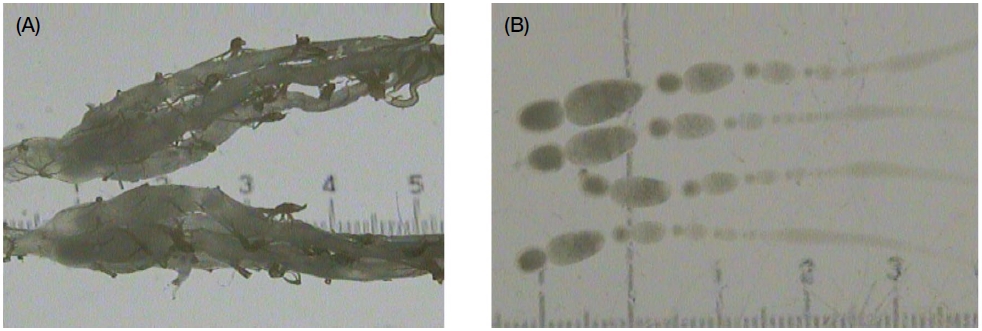
Mated B. terrestris queen have two ovaries, each consisting of four ovarioles (A), and non-matured and matured eggs in ovariole (B).
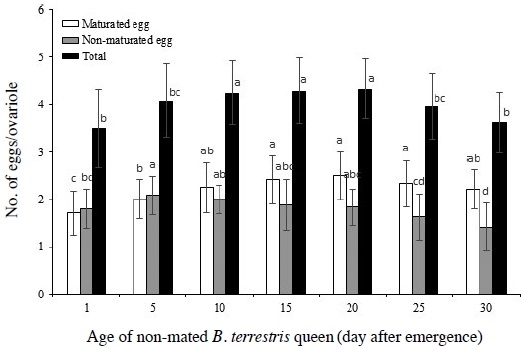
The number of eggs per ovariole at age of non-mated B. terrestris queen. Twenty four ovarioles of three non-mated B. terrestris queens were alloted for each experimental age of queen regime. There were significant differences in number of eggs per ovariole at age of non-mated queens at P<0.0001 using the one-way ANOVA.
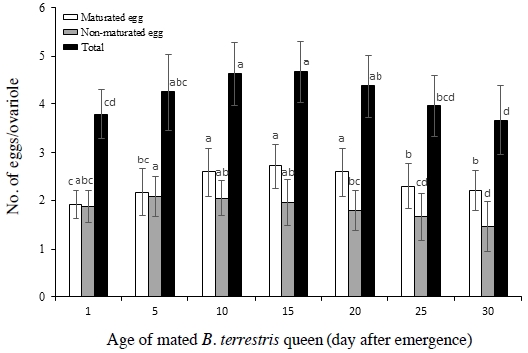
The number of eggs per ovariole at age of mated B. terrestris queen. Twenty four ovarioles of three mated B. terrestris queens were alloted for each experimental age of queen regime. There were significant differences in number of eggs per ovariole at age of mated queens at P<0.0001 using the one-way ANOVA.
우화 후 일별로 미교미 및 교미 여왕벌의 난소소관당 총 난수를 비교 조사하였다 (Fig. 4). 교미 여왕벌의 난수는 3.7~4.7개로 미교미 여왕벌 (3.5~4.3개)보다 0.2~1.2개 더 많아, 교미한 여왕벌의 난소가 미교미 여왕벌보다 다소 빨리 발육하는 것으로 생각되었지만, 통계적으로 차이가 없었다 (t-test: 우화 1일, t(46)=-1.462, P=0.150; 우화 5일, t(46)=-0.736, P=0.466; 우화 10일, t(46)=-1.964, P=0.056; 우화 15일, t(46)=-1.956, P=0.057; 우화 20일, t(46)=-0.225, P=0.823; 우화 25일, t(46)=0.0001, P=1.000; 우화 30일, t(46)=-0.214, P=0.832). 이와 같은 결과에 대해서는 실험곤충 수를 많이 하여 추가적인 실험을 할 필요가 있을 것으로 생각된다. 결론적으로 미교미와 교미 여왕벌의 난소소관 내 난수는 우화 후 일수에 따라서 영향을 받는 것으로 나타났으며, 미교미 여왕벌은 우화 20일부터, 교미 여왕벌은 우화 15일부터 알 수가 감소하는 것을 알 수 있었다. Medler (1962)는 여왕벌이 우화 직후부터 5일 동안에는 대부분 알이 작거나 중간 크기였고, 25일까지는 큰 알이 발견되었지만 26~50일 사이에는 큰 알이 사라지는 알의 재흡수가 일어난다고 하였다.

Comparison of the number of eggs per ovariole at age of non-mated and mated B. terrestris queen. There was no significant difference in number of eggs per ovariole at age of non-mated and mated queens at P<0.05 using t-test.
우화 후 일별로 미교미와 교미 여왕벌의 저정낭 크기를 조사한 결과 (Figs. 5, 6, 7), 미교미 여왕벌의 저정낭의 우화 후 일별 단경은 2.8±0.2~3.4±0.6 μm, 장경은 3.7±0.3~4.1±0.8 μm로 우화 15일 이후부터 저정낭의 크기가 다소 작아지는 경향을 보였지만 (Figs. 5A, 6), 차이가 없었다 (단경 F(3,14)=0.904, P=0.519; 장경 F(6,5.965)=0.636, P=0.702). 교미 여왕벌의 저정낭 크기는 단경은 3.2±0.3~3.9±0.5 μm μm, 장경은 3.7±0.3~4.2±0.5 μm로 (Figs. 5B, 7), 미교미 여왕벌의 저정낭보다 다소 컸다. 이는 아마도 교미 여왕벌의 저정낭에 정자가 가득 저장되어 있기 때문인 것으로 판단된다 (Fig. 5B). 교미한 여왕벌의 저정낭은 우화 후 일수에 영향을 받지 않았다 (단경 F(6,14)=1.922, P=0.147; 장경 F(6,14)=0.468, P=0.821). 미교미와 교미 여왕벌의 일별 저장낭 크기 역시 통계적으로 유의성이 없었다 (t-test: 단경; 우화 1일, t(4)=-2.353, P=0.078; 우화 5일, t(4)=-0.938, P=0.401; 우화 10일, t(4)=-1.717, P=0.161; 우화 15일, t(4)=-1.182, P=0.303; 우화 20일, t(4)=-1.228, P=0.287; 우화 25일, t(4)=0.263, P=0.806; 우화 30일, t(4)=-0.992, P=0.377, 장경; 우화 1일, t(4)=-0.158, P=0.882; 우화 5일, t(4)=-1.066, P=0.346; 우화 10일, t(4)=-0.216, P=0.840; 우화 15일, t(4)=-0.114, P=0.915; 우화 20일, t(4)=-1.026, P=0.363; 우화 25일, t(4)=-1.021, P=0.365; 우화 30일, t(4)=-0.130, P=0.903).
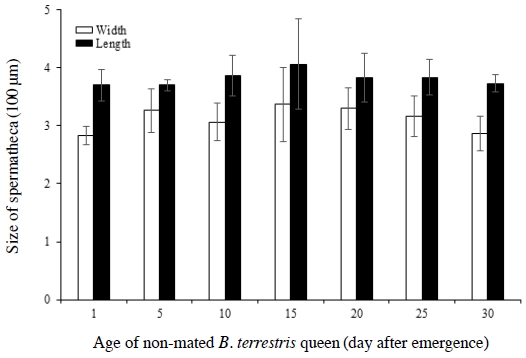
Spermatheca size at age of non-mated B. terrestris queen. The spermathecae of three non-mated B. terrestris queens were alloted for each experimental age of queen regime. There was no significant difference in spermatheca size at age of non-mated queens at P<0.05 using the one-way ANOVA test.
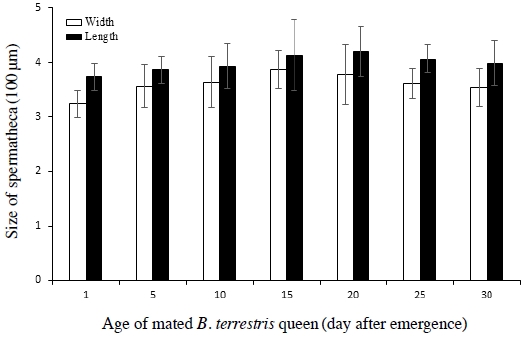
Spermatheca size at age of mated B. terrestris queen. The spermathecae of three mated B. terrestris queens were alloted for each experimental age of queen regime. There was no significant difference in spermatheca size at age of mated queens at P<0.05 using the one-way ANOVA test.
이상의 미교미 및 교미 여왕벌의 난소소관 내 난수와 저정낭의 크기 등 난소발육을 조사한 결과, 교미 여왕벌의 난소가 미교미 여왕벌보다 다소 발육이 좋은 경향을 보였다. 우화 일별 난소소관당 난수와 저정낭 크기로 볼 때, 교미 여왕벌은 우화 후 15일째, 미교미 여왕벌은 20일째에 난소가 가장 발달되었다. 서양뒤영벌 (B. terrestris)의 교미에 적당한 여왕벌의 나이는 5~12일 (Duchateau, 1985), 호박벌 (B. ignitus) 여왕벌의 최적 성적 성숙시기는 9~12일이었다 (Yoon et al., 2018).
2. 미교미, 교미 수벌의 우화 후 일별 정자수
서양뒤영벌 수벌의 우화 후 일별 정자수를 알아보기 위해서 우화 1일부터 40일까지 미교미와 교미한 수벌의 정자수를 비교 조사하였다 (Figs. 8, 9). 미교미 수벌의 우화 1일째 정자수는 236,000±113,780개였고, 우화 3일부터 증가하여 우화 9일에는 497,780±178,240개로 가장 많았고, 우화 1일보다 2.1배나 증가하였다. 우화 12일 (485,330±150,190개)부터 우화 30일 (326,000±138,110개)까지는 서서히 줄어드는 경향을 보였다. 하지만 우화 35일 (87,100±45,330개)부터는 급격하게 줄어들어, 우화 40일에는 37,330±8,260개로 정자수가 가장 많았던 우화 9일째보다 무려 13.3배나 줄었다. 미교미 수벌의 정자수는 우화 후 일수에 따라 크게 차이가 있었다 (F(10,65.800)=106.858, P=0.0001).
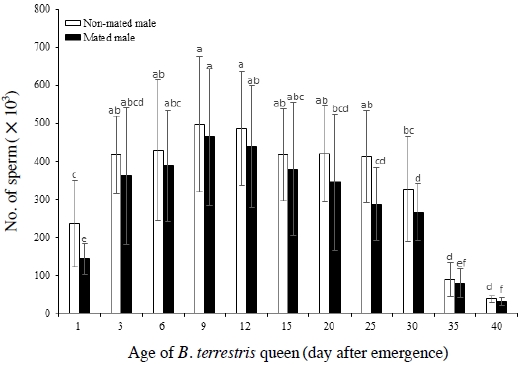
The number of sperm at age of non-mated and mated B. terrestris males. There were significant differences in sperm number at age of non-mated and mated males at P<0.0001 using the one-way ANOVA test.
교미한 수벌의 우화 후 일별 정자수는 미교미 수벌과 유사한 경향을 보였다. 즉 교미한 우화 1일 수벌의 정자수는 142,060±40,110개였고, 우화 9일에는 463,110±179,560개로 가장 많았다. 우화 12일 (438,890±161,560개)부터 우화 30일 (264,670±74,540개)까지는 서서히, 우화 35일 (78,170± 38,000개)부터 급격하게 줄어들어 우화 40일에는 30,330±10,710개였다. 우화 40일째 수벌의 정자수는 우화 9일째보다 15.3배나 감소하였고, 우화 일별로 정자수는 영향을 받았다 (F(10,70.503)=76.354, P=0.0001). 교미 수벌의 정자수는 미교미 수벌보다 1.1~1.7배나 적었다. 서양뒤영벌 수벌의 정자수는 우화 후 9일째에 가장 많았다.
생식기 발달과 봉세발달 등으로 고려할 때, 호박벌 수벌의 최적 성적 성숙시기는 6~9일 (Yoon et al., 2018), 서양뒤영벌 수벌의 최적 교미시기는 우화 6~10일이었다 (Yoon et al., 2016). Tasei et al. (1998)은 뒤영벌 수벌의 교미는 우화 6~27일까지 가능하지만, 평균 교미나이는 12.1±1.3일이라고 보고하였다. 뒤영벌 수벌은 우화 6일 이후부터 정자가 정소관 (vas deferentiae)으로 이동하여 정소관은 커지고 고환은 작아지며, 각 정소관의 중간부분은 결국 두꺼워지고, 성숙한 정자를 위한 저장기관으로 제공되는 부정소낭 (accessory testis)을 형성한다. 뒤영벌 수벌의 정자수에 관해서 Duchateau and Mariën (1995)은 우화 10~15일 된 수벌의 정자수는 평균 500,000개, Tasei et al. (1998)은 우화 1~20일 된 수벌의 정자수는 4,000~230,000개로 연구자들에 의해서 상당한 차이가 있었다. Tasei et al. (1998)은 다중 교미한 수벌의 정자수는 1회 교미한 수벌보다 줄어든다고 하였다.
3. 미교미, 교미 수벌 및 교미 여왕벌의 저정낭 내 정자수
우화 1일, 3일 된 미교미, 교미 서양뒤영벌 수벌과 교미 여왕벌의 저정낭 내 정자수를 비교 조사하였다 (Fig. 10). 미교미와 교미 수벌의 정자수는 우화 1일째보다 우화 3일 째가 많았고, 증가의 폭은 미교미 (1.7배)보다 교미 수벌 (2.5배)의 정자수가 더 컸다. 교미 여왕벌의 저정낭 내 정자수 역시 우화 1일 (10,484±4,278개)보다 우화 3일 (14,780±3,806개)이 1.4배나 많았다 (t-test: t(19)=-2.73, P=0.013). 우화 1일째의 미교미, 교미 수벌과 저정낭 내 정자수를 비교 분석한 결과 (Fig. 10), 저정낭 내 정자수는 미교미 수벌보다 22.5배, 교미 수벌보다는 13.6배나 줄었으며, 통계적으로 고도의 유의성이 확인되었다 (F(1,27)=7.93, P=0.0001). 우화 3일째 미교미, 교미 수벌과 저정낭 내 정자수 역시, 우화 1일과 비슷한 경향으로 저정낭 내 정자수는 미교미 수벌보다 28.1배, 교미 수벌보다는 24.4배 줄었다 (F(2,51)=59.85, P=0.0001) (Fig. 10). 이러한 결과는 우화 6~18일 된 서양뒤영벌 수벌과 교미한 여왕벌의 저정낭 속의 평균 정자수는 5,800~36,200개로 미교미 수벌보다 6.4~39.8배나 적고 (Tasei et al., 1998), 교미 여왕벌의 저정낭에는 수벌 저장낭의 1/10인 40,000~60,000개의 정자수를 가지고 있다고 한 보고 (Röseler, 1973)와 정자수에 있어서 차이가 있었다. Baer and Schmid-Hempel (2000)은 뒤영벌 여왕벌은 일생동안 저정낭에 있는 단지 소량의 정자만을 사용한다고 하였다.
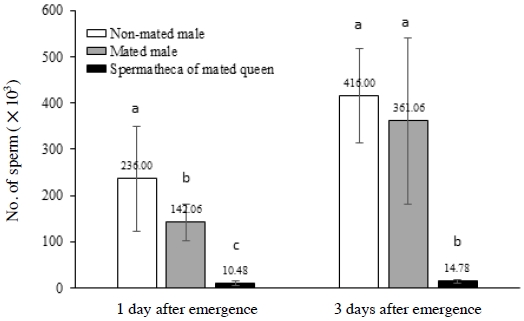
The number of sperm of non-mated, mated B. terrestris males and spermatheca of mated queens aged 5 days after emergence. There were significant differences in sperm number of non-mated, mated males and spermatheca of mated queens at P<0.0001 using the one-way ANOVA test.
이상의 우화 후 일별 서양뒤영벌 여왕벌의 난소발육과 수벌의 정자수, 저정낭의 정자수 등을 조사한 결과, 비록 통계적으로 차이는 없었지만, 교미 여왕벌의 난소가 미교미 여왕벌보다 다소 발육된 경향을 보였다. 우화 후 일별 난소소관당 난수와 저정낭 크기 등 난소 발육조사 결과, 교미 여왕벌의 난소는 우화 후 15일째, 미교미 여왕벌은 20일째에 발육이 가장 좋았다. 일별 수벌의 정자수 조사 결과, 미교미 및 교미 수벌의 정자수는 우화 9일째가 가장 많았고, 우화 35일 이후부터 급격히 줄어들었다. 교미 여왕벌의 저정낭 내 정자수는 미교미 수벌보다 22.5~28.1배, 교미 수벌보다는 13.6~24.4배나 줄어든다는 것을 확인하였다.
적 요
서양뒤영벌 (B. terrestris)의 우량형질을 확보하기 위하여 우화 후 일별 여왕벌의 난소 발육과 정자 생산성을 조사하였다. 그 결과, 교미 여왕벌의 난소가 미교미 여왕벌보다 다소 발육된 경향을 보였다. 난소소관당 난수와 저정낭 크기로 볼 때, 교미 여왕벌은 우화 후 15일째, 미교미 여왕벌은 20일째에 난소 발육이 가장 좋았다. 일별 수벌의 정자수 조사 결과, 미교미 수벌의 정자수는 우화 1일에 23.6만개였고, 우화 9일째가 49.7만개로 가장 많았으며, 우화 35일 (8.7만개) 이후 급격하게 정자수가 줄어들었다. 교미 수벌의 정자수는 미교미 수벌보다 1.1~1.7배나 적었다. 수벌의 정자수는 우화 후 9일째에 가장 많았다. 교미 여왕벌의 저정낭 내 정자수는 미교미 수벌보다 22.5~28.1배, 교미 수벌보다는 13.6~24.4배 줄었다.
Acknowledgments
본 연구는 농촌진흥청 국립농업과학원 농업과학기술 연구개발사업 (과제번호: PJ01355903)의 지원에 의해 이루어진 것입니다.
References
-
Baer, B. and P. Schmid-Hemple. 2000. The artificial insemination of bumble-bee queens. Insect. Soc. 47: 183-187.
[https://doi.org/10.1007/PL00001699]

-
Baer, B., P. Schmid-Hemple, J. H. Hoeg and J. J. Boomsma. 2003. Sperm length, sperm storage and mating system characteristics in bumblebees. Insect. Soc. 50: 101-108.
[https://doi.org/10.1007/s00040-003-0641-0]

-
Baer, B., R. Maile, P. Schmid-Hemple, E. D. Morgan and G. R. Jones. 2000. Chemistry of a mating plug in bumblebees. J. Chem. Ecol. 26: 1869-1875.
[https://doi.org/10.1023/A:1005596707591]

- Bergstom, G. 1981. Chemical composition, similarity and dissimilarity in volatile secretions: examples of indications of biological function, Les mėdiateurs chimiques agissant sur le comportment des insects. pp. 289-296. Les colloques de I’NRA.
-
Buchmann, S. L. and J. P. Hurley. 1978. A biophysical model for buzz pollination in angiosperms. J. Theor. Biol. 72: 639-657.
[https://doi.org/10.1016/0022-5193(78)90277-1]

-
Cameron, S. A., H. M. Hines and P. H. Williams. 2007. A comprehensive phylogey of the bumble bees (Bombus). Biol. J. Linn. Soc. 91: 161-188.
[https://doi.org/10.1111/j.1095-8312.2007.00784.x]

-
De Ruijter, A. 1997. Commercial bumblebee rearing and its implications. Proc, 7th Int. Symp. Pollination, Acta Hort. 437: 261-269.
[https://doi.org/10.17660/ActaHortic.1997.437.30]

-
Djegham, Y., J. C. Verhaeghe and P. Rasmout. 1994. Coupulation of Bombus terrestris L. (Hymenoptera: Apidae) in captivity. J. Apicul. Res. 33: 15-20.
[https://doi.org/10.1080/00218839.1994.11100844]

- Duchateau, M. J. 1985. Analysis of some methods for rearing bumblebee colonies. Apidologie 16: 225-227.
-
Duchateau, M. J. and H. H. W. Velthuis. 1988. Development and reproductive strategies in Bombus terrestris colonies. Behavior 107: 186-207.
[https://doi.org/10.1163/156853988X00340]

-
Duchateau, M. J. and J. Mariën. 1995. Sexual biology of haploid and diploid males in the bumblebee Bombus terrestris. Insect. Soc. 42: 255-266.
[https://doi.org/10.1007/BF01240420]

-
Duvoisin, N., B. Boris and P. Schmid-Hemple. 1999. Sperm transfer and male competition in a bumblebee. Anim. Behav. 58: 743-749.
[https://doi.org/10.1006/anbe.1999.1196]

- Free, J. B. 1993. Insect pollination of crops. 2nd ed., Academic Press, London. pp. 684.
-
Friden, F. 1966. Some studies on bumblebees in captivity. Bee World Suppl. 47: 151-166.
[https://doi.org/10.1080/0005772X.1966.11097125]

- Heinrich, B. 1979. Bumblebee economics. Harvard University Press. Cambridge, Massa. pp. 245.
- Iwasaki, M. 1995. Introduction of commercial bumblebees into Japan. Honeybee Sci. 16: 17-21.
-
Korner, P. and P. Schmid-Hempel. 2003. Effects of sperm on female longevity in the bumble-bee Bombus terrestris L. Proc. R. Soc. Lond. B. 270: 227-229.
[https://doi.org/10.1098/rsbl.2003.0039]

- Masahiro, M. 2000. Pollination of crops with bumblebee colonies in Japan. Honeybee Sci. 21: 17-25.
-
Medler, J. T. 1962. Development and absorption of eggs in bumblebee (Hymenoptera : Apidae). Can. Ent. 94: 825-833.
[https://doi.org/10.4039/Ent94825-8]

-
Richards, K. W. 1977. Ovarian development of queen and worker bumble bees (Hymenoptera: Apidae) in Southern Alberta. Can. Entomol. 109: 109-116.
[https://doi.org/10.4039/Ent109109-1]

-
Röseler, P. F. 1973. Die anzahl der spermien im receptaculum seminis von hummelkőniginnen (Hymenoptera, Apoidea, Bombinae). Apidologie. 4: 267-274.
[https://doi.org/10.1051/apido:19730303]

- SPSS PASW® Statistics 22.0. 2013. PASW® Core System User’s Guide, SPSS inc. USA.
-
Sauter, A. and M. J. M. Brown. 2001. To copulate or not? The importance of female status and behavioural variation in predicting copulation in a bumble bees. Anim. Behav. 62: 221-226.
[https://doi.org/10.1006/anbe.2001.1742]

- Svensson, B. G. 1980. Species-isolating mechanisms in male bumble bees (Hymenoptera, Apidae). 176 pp. Acta Universitatis upsaliensis.
-
Tasei, J. N., C. Moinard, L. Moreau, B. Himpens and S. Guyonnaud. 1998. Relationship between aging, mating and sperm production in captive Bombus terrestris. J. Apicul. Res. 37: 107-113.
[https://doi.org/10.1080/00218839.1998.11100962]

-
Van Honk, C. G. J., H. H. W. Velthuis and P. F. Röseler. 1978. A sex pheromone from the mandibular glands in bumblebee queens. Experientia. 34: 838-839.
[https://doi.org/10.1007/BF01939651]

-
Vogt, F. D., B. Heinrich, T. O. Dabolt and H. L. McBath. 1994. Ovary development and colony founding in subarctic and temperate-zone bumble bee queens. Can. J. Zool. 72: 1551-1556.
[https://doi.org/10.1139/z94-206]

-
Vogt, F. D., B. Heinrich and P. Catherine. 1998. Ovary development in bumble bee queens: the influence of abominal temperature and food availability. Can. J. Zool. 76: 2026-2030.
[https://doi.org/10.1139/z98-146]

- Williams, P. H. 1991. The bumble bees of the Kashmir Himalaya (Hymenoptera: Apidae, Bombini). Bull. Nat. Hist. Mus. (Ent.). 60: 1-204.
- Williams, P. H. 1998. An annotated checklist of bumble bees with an analysis of patterns of description (Hymenoptera: Apidae, Bombini). Bull. Nat. Hist. Mus. (Ent.). 67: 79-152.
- Yoon, H. J., Y. I. Mah, M. Y. Lee and I. G. Park. 1999. Studies on ovary development and mating of bumblebee, Bombus ignitus Smith. Korean J. Apicul. 14: 35-42.
- Yoon, H. J., S. E. Kim, Y. S. Kim and S. B. Lee. 2004. Colony developmental characteristics of the bumblebee queen, Bombus ignitus by the first oviposition day. Int. J. Indust. Entomol. 8: 139-143.
- Yoon, H. J., Y. S. Kim, S. B. Lee and Y. H. Cho. 2006. An easy method for collecting sperm of bumblebees. Korean J. Apicul. 21: 157-162.
-
Yoon, H. J., K. Y. Lee, M. Shin and S. Y. Kim. 2016. Sexual maturity and mating ability of the bumblebees, Bombus terrestris. Korean J. Apicul. 31: 305-313.
[https://doi.org/10.17519/apiculture.2016.11.31.4.305]

- Yoon, H. J., K. Y. Lee and H. J. Ko. 2018. Sexual Maturity time of reproductive organ development and mating in the Korean native bumblebee, Bombus ignitus. Korean J. Appl. Entomol. 57: 329-337.
